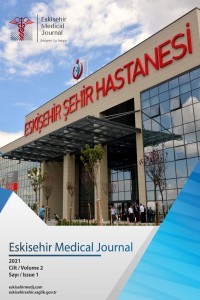PES PLANUS, TETİK NOKTA VE KAS GÜCÜ ARASINDAKİ İLİŞKİ
Fasya, Pes planus, Tetik nokta, El kavrama gücü
THE RELATIONSHIP BETWEEN PES PLANUS, TRIGGER POINTS AND MUSCLE STRENGTH
Fascia, Hand grip strength, Pes planus, Trigger point,
___
- 1. Shibuya N, Jupiter DC, Ciliberti LJ, VanBuren V, La Fontaine J. Characteristics of adult flatfoot in the United States. Foot Ankle Surg 2010; 49 : 363-8.
- 2. Kerr CM, Zavatsky AB, Theologis T, Stebbins J. Kinematic differences between neutral and flat feet with and without symptoms as measured by the Oxford foot model. Gait posture 2019; 67:213-8.
- 3. Wiewiorski M, Valderrabano V. Painful flatfoot deformity. Acta Chir Orthop Traumatol Cech 2011; 78: 20-6.
- 4. Leung AKL, Mak AFT, Evans JH. Biomechanical gait evaluation of the immediate effect of orthotic treatment for flexible flat foot. Prosthet Orthot Int 1998; 22 :25-34.
- 5. Khamis A, Yizhar Z. Effect of feet hyperpronation on pelvic alignment in a standing position. Gait Posture 2007; 25:127-34.
- 6. Borges CS, Fernandes LFR, Bertoncello D. Relationship between lumbar changes and modifications in the plantar arch in women with low back pain. Acta Orthop Bras 2013;21:135-8.
- 7. Abdel-Raoof N, Kamel D, Tantawy S. Influence of second-degree flatfoot on spinal and pelvic mechanics in young females. Int J Ther Rehabil 2013; 20:428-34.
- 8. Yılmaz N, Erdal A, Demir O. A comparison of dry needling and kinesiotaping therapies in myofascial pain syndrome: A randomized clinical study. Turk J Phys Med Rehab 2020; 66:351-9.
- 9. Aksu Ö, Doğan YP, Çağlar NS, Şener BM. Comparison of the efficacy of dry needling and trigger point injections with exercise in temporomandibular myofascial pain treatment. Turk J Phys Med Rehab 2019;65:228-35.
- 10. Zuil-Escobar JC, Martínez-Cepa CB, Martín-Urrialde JA, Gómez-Conesa A. Prevalence of myofascial trigger points and diagnostic criteria of different muscles in function of the medial longitudinal arch. Arch Phys Med Rehabil 2015;96:1123-30.
- 11. Bird AR, Payne CB. Foot function and low back pain. Foot 1999; 9:175-80.
- 12. Kang JH, Chen MD, Chen SC, Hsi WL. Correlations between subjective treatment responses and plantar pressure parameters of metatarsal pad treatment in metatarsalgia patients: a prospective study. BMC Musculoskelet Disord 2006;7:1-8.
- 13. Kosashvili Y, Fridman T, Backstein D, Safir O, Ziv YB. The correlation between pes planus and anterior knee or intermittent low back pain. Foot Ankle Int 2008; 29: 910-3.
- 14. Ceyhan Ç, Sanalan GB, Akkaya N, Şahin F. Evaluation of relationship between pes planus and axial pain in medical school students. Pam Med J 2017; 10:158-64.
- 15. Stecco C. Functional Atlas of the Human Fascial System, Churchill Livingstone, Edinburgh, 2015.
- 16. Antonio S, Wolfgang G, Robert H, Fullerton B, Carla S. The anatomical and functional relation between gluteus maximus and fascia lata J Body Mov Ther 2013;17: 512-7.
- 17. Benjamin M. The fascia of the limbs and back a review. J Anat 2009;214:1-18.
- 18. Stecco C, Porzionato A, Macchi V et al. The Expansions of the Pectoral Girdle Muscles onto the Brachial Fascia: Morphological Aspects and Spatial Disposition, Cells Tissues Organs. 2007; 188:320-9.
- 19. Nilsson MK, Friis R, Michaelsen MS, Jakobsen PA, Nielsen RO. Classification of the height and flexibility of the medial longitudinal arch of the foot. J Foot Ankle Res 2012; 5:1-9.
- 20. Simons DG, Travell JG, Simons LS. Travell and Simons’ Myofascial Pain and Dysfunction: The Trigger Point Manual. Vol 1. 2nd ed. Baltimore. MD: Williams & Wilkins 1999.
- 21. Gallagher EJ, Liebman M, Bijur PE. Prospective validation of clinically important changes in pain severity measured on a visual analog scale. Ann Emerg Med 2001; 38:633–8.
- 22. Ten Hoor GA, Musch K, Meijer K, Plasqui G. Test-retest reproducibility and validity of the back-leg-chest strength measurements. IES 2016; 24:209-16.
- 23. Angin S, Crofts G, Mickle KJ, Nester CJ. Ultrasound evaluation of foot muscles and plantar fascia in pes planus. Gait posture 2014; 40: 48-52.
- 24. Casato G, Stecco C, Busin R. Role of fasciae in nonspecific low back pain, Eur J Transl Myol 2019;29:8330.
- 25. Aydog ST, Özçakar L, Tetik O, Demirel HA, Hascelik Z, Doral MN. Relation between foot arch index and ankle strength in elite gymnasts: a preliminary study. Br J Sports Med 2005;39:e13.
- 26. Nakao H, Imaoka M, Hida M, et al. Correlation of medial longitudinal arch morphology with body characteristics and locomotive function in community-dwelling older women: A cross-sectional study. Journal of Orthopaedic Surgery 2021;29: 23094990211015504.
- 27. Tuna H. Pedobarographic evaluation in foot disorders. Turk J Phys Med Rehab 2005;51(suppl B):51-4.
- ISSN: 2718-0948
- Yayın Aralığı: Yılda 3 Sayı
- Başlangıç: 2020
- Yayıncı: Eskişehir Şehir Hastanesi
NADİR BİR ANATOMİK VARYASYON: ÇİFT REKÜRREN LARİNGEAL SİNİR
TİP II DİYABET TANILI PERİFERİK ARTER HASTALARINDA ENDOVASKÜLER REVASKÜLARİZASYON SONUÇLARI
İbrahim Çağrı KAYA, Halil İbrahim BULUT
SARS-COV-2 VE İNFLUENZA KOENFEKTE HASTADA İNVAZİF TRİCHOSPORON ENFEKSİYONU: BİR OLGU SUNUMU
Zeynep GÜVENÇ, Cüneyt AYTEKİN, Fatih BOYVAT, Umut ÖZYER, Ali HARMAN
Evren TECER, Sümeyra ALAN YALIM, Mustafa ALDEMİR
İNFLAMATUAR BAĞIRSAK HASTALARINDA SERUM RESOLVİN D1 VE E1 DÜZEYLERİNİN DEĞERLENDİRİLMESİ
İrfan KÜÇÜK, Ersin TURAL, Başak ÇAKIR GÜNEY, Musa SALMANOĞLU, Mustafa KAPLAN
Ahmet Lütfü SERTDEMİR, Mustafa DURAN, Ahmet Taha ŞAHİN, Abdullah İÇLİ, Mustafa ÇELİK, Sefa TATAR, Yakup ALSANCAK
PRIMER DİFFÜZ BÖBREK TUTULUMU ILE PREZENTE OLAN BİR MALT LENFOMA
Abdulkadir KARISMAZ, Elif SUYANİ, Mehmet Hilmi DOĞU, Gülben ERDEM HUQ, Istemi SERIN, Osman YOKUŞ
PES PLANUS, TETİK NOKTA VE KAS GÜCÜ ARASINDAKİ İLİŞKİ
Fulya BAKILAN, Burcu ORTANCA, Ayşe AYDEMİR EKİM, Onur ARMAĞAN
